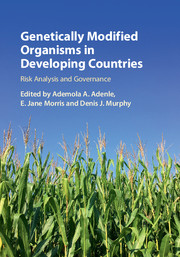Book contents
- Genetically Modified Organisms in Developing CountriesRisk Analysis and Governance
- Genetically Modified Organisms in Developing Countries
- Copyright page
- Contents
- Contributors
- Foreword
- 1 Introduction
- Part I Risk Analysis Methodology and Decision-Making
- Part II Diversification of Expertise
- Part III Risk-Analysis-Based Regulatory Systems
- 13 The Risk Analysis Framework and Biosafety Policy
- 14 The Precautionary Principle as a Barrier to GMO Risk Analysis: Elicitation of Experts’ Viewpoints
- 15 How Do Socio-Political Disputes Concerning GMOs Influence Decision-Making in Developing Countries?
- 16 Biosafety Communication: Beyond Risk Communication
- 17 The Role of Mass Media and Lobbies in the Formulation of GMO Regulations
- Part IV Case Studies from Developing Countries
- Index
- References
16 - Biosafety Communication: Beyond Risk Communication
from Part III - Risk-Analysis-Based Regulatory Systems
Published online by Cambridge University Press: 05 July 2017
- Genetically Modified Organisms in Developing CountriesRisk Analysis and Governance
- Genetically Modified Organisms in Developing Countries
- Copyright page
- Contents
- Contributors
- Foreword
- 1 Introduction
- Part I Risk Analysis Methodology and Decision-Making
- Part II Diversification of Expertise
- Part III Risk-Analysis-Based Regulatory Systems
- 13 The Risk Analysis Framework and Biosafety Policy
- 14 The Precautionary Principle as a Barrier to GMO Risk Analysis: Elicitation of Experts’ Viewpoints
- 15 How Do Socio-Political Disputes Concerning GMOs Influence Decision-Making in Developing Countries?
- 16 Biosafety Communication: Beyond Risk Communication
- 17 The Role of Mass Media and Lobbies in the Formulation of GMO Regulations
- Part IV Case Studies from Developing Countries
- Index
- References
Summary
- Type
- Chapter
- Information
- Genetically Modified Organisms in Developing CountriesRisk Analysis and Governance, pp. 187 - 199Publisher: Cambridge University PressPrint publication year: 2017
References
- 1
- Cited by



